Page 20
~ The Study of Threes ~
http://threesology.org
| Hybrids page 1 | Hybrids page 2 | Hybrids page 3 | Hybrids page 4 | Hybrids page 5 |
| Hybrids page 6 | Hybrids page 7 | Hybrids page 8 | Hybrids page 9 | Hybrids page 10 |
| Hybrids page 11 | Hybrids page 12 Playmate God |
Hybrids 13 Economics 1 |
Hybrids 14 Economics 2 |
Hybrids 15 Economics 3 |
| Hybrids 16 Economics 4 |
Hybrids 17 Economics 5 |
Hybrids 18 Economics 6 |
Hybrids 19 Economics 7 |
Hybrids 20 Language 1 |
| Hybrids 21 Language 2 |
Hybrids 22 Language 3 |
Hybrids 23 Language 4 |
Hybrids 24 Physics |
Hybrids 25 |
| Hybrids 26 | Hybrid 27 |
Visitors as of 30th July, 2021
Note: On December 18, 2021, I lost the original contents of this page upon opening the file (which was not lost), and found the entire contents missing. This is what I get for trying to work on several pages at the same time. I am inclined to think I simply placed the contents on another page which can not at present be located. I shall retain the contents of the entire C: drive for later examination, but am engage in a momentum for which I can not waste too much time in searching for the page.
Although I am unable to recreate what I said in the same way, the content can be assessed since I am essentially recreating previous ideas and placing them into a new context along with additional material associated with some of the images which I retain... having placed them in a separate folder In an attempt to back-step in an effort to regain the orientation of my previous perspectives, I will begin this second effort of this page's contents by referring to the human brain as a hybrid from some original source that we can initially refer to as the origin of all brains; even if the brains of other creatures do not share the same history. The simple reference is meant to provide a distinction being a hybridization consisting of two or more elements and that from which they arose... we can imagine as a single item. Hence, the human brain is a multiplicity arising from a singularity. (Simply put, a composite of two or more is thought always to have an origination where only one item existed.) The idea of two items (as a composite or separately) occurring at the same time, is typically a foreign idea to be contemplated. For example, though we note an equanimity with the birth of twins or the yin/yang concept, it is generally considered that one preceded the other, unless we prefer to pursue the idea as a type of chicken and egg controversy.
The ideas that "two" is the minimum requirement for a hybrid and that it plays a significant role in understanding language development, can be viewed as separate ideas. I propose the first as an initial query into understanding the origin of multiple structures in and outside the immediate sphere of human concern, while it appears Noam Chomsky proposed the idea that language begin with the usage of two words. (Two word utterances)
From such an early beginning of linguistics concerning the usage of two-word utterances, has come studies examining word order and whether such an order precedes comprehension: (Word Order in Early Two and Three Word Utterances: Does Production Precede Comprehension? by Robin S. Chapman and Jon F. Miller)
The stages outlined sequentially as pre-ONE or pre-beginning..., then ONE,... the TWO... and then the THREE or THIRD (frequently denoted as "many, much, heap, more, a lot, variety", etc...), is a common theme found amongst those doing research on some aspect of origination in their respective field of interest; just as the beginning of the Universe has been described with the phrase "The first three minutes" to denote a specifically important time period grouping. We tend to (but not always) group into threes just as we group numbers into groups of threes separated by a comma to indicate a grouped quantification. For example, the hundreds group before the thousands group before the tens-of-thousands group before the hundreds-of-thousands group before... etc... (123,456,789,). It is a grouping methodology used by the United States in designating Social security numbers with a slight variation. It uses a 2-3-4 assigned designation in a 3-2-4 arrangement. If you are not familiar with the "2-3-4" as a three-patterned ensemble, the correlation being made may not have any extended meaning for you for comparing cognitive streams of recurring activity symbolized by numbers.
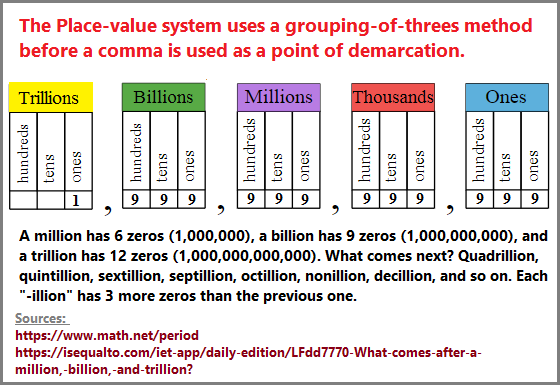
- Examples of the {2-3-4} pattern-of-three model
- Predicting Social Security numbers from public data by Alessandro Acquisti and Ralph Gross
- The first 3 digits of an SSN are called its area number (AN).
- The next 2 are its group number (GN).
- The last 4 are its serial number (SN).
In speaking about language development, it has been said that there are four main stages, though it is known to frequent readers I often identify a presumed "four" as a three-to- one ratio. (How We Acquire Language by Zoe Georgiou):
- Babbling Stage: Babbling is the first stage of language acquisition occurs between birth and approximately 11 months of age. This is when children start
to recognize and produce sounds. The sounds children produce in the babbling stage are universal...
- One-word (Holophrastic) Stage: The one word or holophrastic stage occurs between approximately 11 months of age and 1.5 years of age. By this point in time, children can produce a small number of isolated, single words and many sounds. This is now more language specific rather than universal babbling...
- Two-word Stage: After a few months of producing one-word utterances, a child will begin to use two word utterances and continue to do so until they are around the age of 2.5 years old. These two-word utterances are usually in the form of noun-noun or noun-verb. Much of this is almost identical to one-word utterances, and so for awhile there may be a large overlap in the way they use one-word utterances and two-word utterances...
- Telegraphic Stage: The telegraphic stage is the last stage of language before a child can speak fluently and begins roughly around 2.5 years of age and onward indefinitely until a child has fluent language skills. As Stilwell Pecci (1999:29) points out, "There is no three-word stage as such. What follows is a period of two to three years of astonishing progress on a variety of fronts."
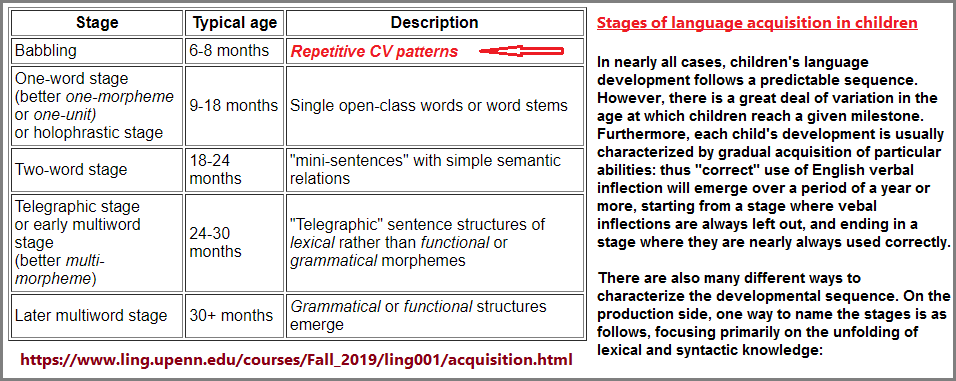
Other accounts of language development may use other, but similarly labeled stages which are defined according to the interests of researches. For example:
- Three overall compartmentalization of stages:
(Stages of Language Development:
Pre-Linguistic and Symbolic Language)
- Pre-Linguistic Language: (four categories: Vegetative sounds, Cooing and laughter, Vocal play, Babbling)
- Linguistic Language: (six stages: Early one-word period, Later one-word period, Two-word period, Three-word period, Four word period, complex utterance period
- Expressive vs. Receptive Language
- Five stages of second language Acquisition: Pre-production, Early production, Speech emergence, Intermediate fluency, Advanced fluency (The Five Stages of Second Language Acquisition)
- Six stages: Pre-talking, Babbling, Holophrastic, Two-word, Telegraphic, Multi-word
(The Stages of Language Acquisition for ELLs (English Language Learners),
April 1, 2021)
- Six stages: Pre-linguistic, Holophrase or one-word sentence, Two-word sentence, Multiple-word sentences, More complex grammatical structures, Adult-like language structures (Six Stages of Language Development by Susan du Plessis, March 30, 2021)
Whereas some researchers customarily look only at adult humans when describing speech, comparing infant humans and animals is quite common among other types of research. Indeed, some viewers of this page may even want to describe all sounds, including the absence there of, as different types of speech/language. No less, let us also consider whether the articulation of vocal sounds (whether labeled as words or not), came first by way of cognitive activity, or did some other activity such as "visual counting" that one might illustrate as early correspondence counting, even though some readers may insist that words had to precede any notion of enumeration. And yet, how do we account for some animals seemingly able to count and yet do not seem to voice numbers... and less, for example, the barks of a dog, caws of a crow, etc., are actually expressions of counting. Different counts can be identified by their emitted sounds, even if we ascribe to sounds associated with basic survival interests as many primate researchers describe when discussing vocalizations of monkeys, etc...
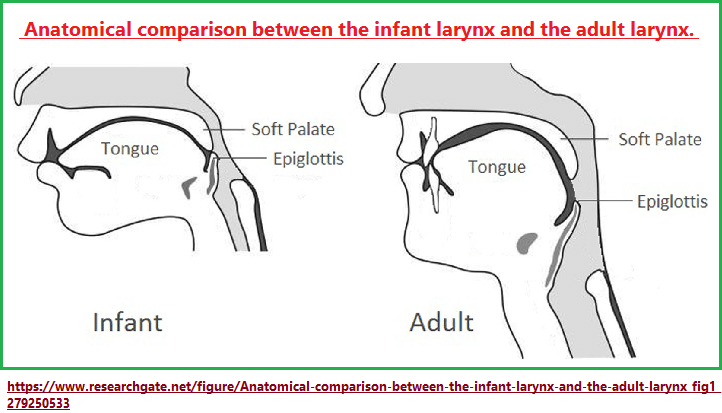
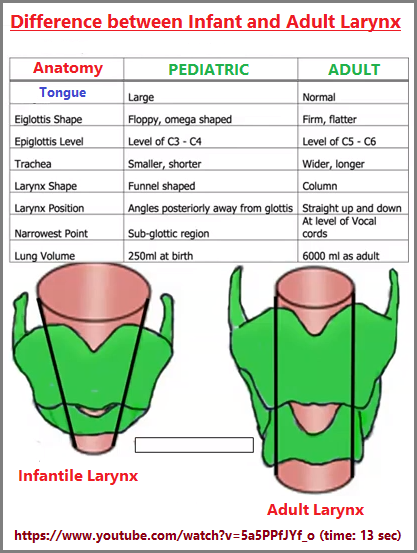
Upon mentioning animals, one should also make mention of the types of sounds, such as vowels in birds (unless animals have other sounds but the brains of humans interpret such sounds to fit into our cognitive profile): The Vowels of Birds by Nathan Pieplow, 26 Dec. 2010
While Noam Chomsky argued for a Language module sometimes described as a language faculty or Universal Grammar inherent in everyone, are we to describe it in the present context as the origin state, the singularity of language or a hybrid function? Or should we instead view language as a composite characteristic with an even more fundamental beginning just as we might view the components of the brain as a composite... as a hybrid of multiple items? All said, what people are looking for is the beginning, the original, the founding corner stone which in some sense is the neighborhood corner store where "everything" happens... at least in a small town or secluded community where some may claim that a contest between two teams results in a "world" champion, because from their frame of reference, the small area in which they are focused on is their world. (Many contests in communities will sometimes evoke the expression among inhabitants that their team is the "world" champion because the winner beat one or more other teams within a given sphere of focused orientation. For example, a Martial arts contest between two or more dojos in a select area may be presumed by some observers as representing "the world" as they know it, and the winner their of as the "world" champion.)
In a study of language termed linguistics, we seek fundamentals. In so doing we come to ascribe to a set of rules by which we seek out confirmation of one or another idea, whereby we internalize notions of good, bad, right, wrong, correct, nonsense, etc., by which we navigate different ideas and reach a tentative conclusion; because either we can not see any alternative within the frame of "world" reference to which we permit ourselves to journey intellectually in, or that even if a stark example did appear to contradict our view and the views of others who have carved out a niche' within the same profile of perception, we might necessarily be inclined to create an argument which dismisses the information as irrelevant or re-label it in order to embrace it under one's control, just as the early Christian (and other) churches re-labeled and modified (crude) "pagan" ideas before using them to increase their flock and thus receive a larger donation from a prescribed 10 percent tithing encoded in a so-called sacred text as one might scribe out a judicial law to sustain an government byway of an enforced code of taxation. All businesses, governments and religions have their own ways of getting more and more money out of the public.
Let us take for example a sentence coined by Chomsky where his world-view of correct and nonsense could well be flip-flopped or otherwise viewed as an incorrect assumption altogether. Chomsky is quoted to have said that the sentence "Colorless green ideas sleep furiously." is grammatically correct English, even though he described it as nonsense; and yet it all depends on whom one is speaking with about it in which context. For example, if one asks a poet engaged in a poetic mood (without the need of any external substance such as drugs or liquor), the sentence may make perfect sense. The same goes for an artist and even a musician, though a mathematician may not readily accept it as correct unless it can be altered into manipulable variables. Similarly, when it is said that a picture is worth a thousand words, some people have reversed this and said that a single word, if not a single letter, is worth a thousand pictures. Flip=flopping ideas around is a common form of conceptualization.
One must ask whether the study of language will enable us to get to the foundation of its origination, or must we turn to the brain, which is itself a composite, just like a cell is a composite of structures called organelles, which may be using the Cell as a type of temporary public transit system and is not, as we might think to assume, THE and the only ONE type of vehicle organelles will use forever. (What I am describing is the Cell as a type of carriage for the organelles which may at sometime become out-dated.) What if organelles start to jump ship (so to speak), and instead want to use some sort of different ground, air or space transportation system? Likewise, while it is easy for humans to claim that language "is what it is" because it occurs as it does and thus was at one time the accepted and expected model for transport but has now been usurped by cellphones, television, radio and other electronics driven devices, this may not necessarily be all that will be in terms of an organic state. Indeed, we can easily consider that the present organic state of speech/language production is due to some trail ancient humans took by accident and that instead, another... more linguistically profitable trail still awaits us. Such speculations aside, we must play the hand we are dealt, or make up a new game such as a synthetic voice as might be used for Artificial intelligence.
Hibridizations of language study can be seen in a lineup of enumerated profiles which different researchers think are important in their respective interests. If one uses the word "language" instead of "linguistics", different enumerations will appear. The point is that we need to acknowledge that the study of languages labeled as linguistics, is particularly conserved, and that this conservation can be seen occurring across the spectrum of studies in our educations systems; leading me to the conclusion that there is an environmental reason for this we need to be taking into consideration, even more so upon recognizing the existence of an incrementally deteriorating environment.
- (ONE) Vocabulary knowledge is the single most important area of language proficiency. (A Brief Study of English Language Proficiency: Employability) by V. Chandra Sekhar Rao
- (TWO) (No examples were found during a short search.)
- (THREE) The Three Functions Of Language: ideational, textual, and interpersonal. (Language: The Three Functions Of Language By Halliday)
- (FOUR) linguists examine the components of language—sounds, words, sentences, and meaning—as a system of rules and universals. (What is linguistics?)
- (FIVE) Five components of language: morphology, syntax, semantics, pragmatics and phonology. ( Four Components of Language by Gabrielle Cormace MS CF SLP)
- (SIX) (What are the main aspects of linguistic?)
- Phonetics - the study of speech sounds in their physical aspects.
- Phonology - the study of speech sounds in their cognitive aspects.
- Morphology - the study of the formation of words.
- Syntax - the study of the formation of sentences.
- Semantics - the study of meaning.
- Pragmatics - the study of language use.
- (SEVEN) Instrumental. It used to express people's needs or to get things done.
(What are the functions of language according to Halliday?)
- Regulatory. This language is used to tell others what to do.
- Interactional. Language is used to make contact with others and form relationships.
- Personal.
- Heuristic.
- Imaginative.
- Representational.
- (Eight) There are mainly five components of any language they are phonemes, morphemes, lexemes, syntax, as well as context. Along with grammar, semantics, and pragmatics, (Components of Linguistics)
Please note I did not find any criteria beyond "8", though they may exist and be found if I were to use some other search criteria.

Despite the several separations of language study into different areas, we can focus on words which is sometimes viewed in the context of (The 8 Parts of Speech by Rebecca Ray and Kristy Littlehale):
- Noun (a person, place, thing, or idea)
- Pronoun (stands in for a noun)
- Adjective (a quality of a noun)
- Preposition (links a noun to another word)
- Verb (action or state of being)
- Adverb (describes a verb, adjective, or another adverb)
- Conjunction (joins words, clauses, and sentences)
- Interjection (short exclamation, sometimes inserted into a sentence)
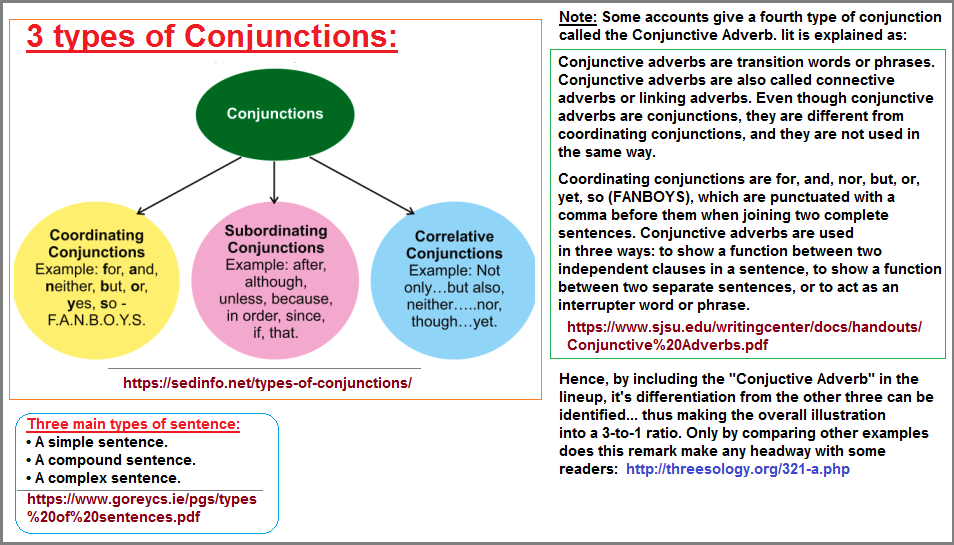
In the foregoing, we can (for example) divide the list into a group of three by identifying those associated with a noun, a verb and the last two in the list might be referred to as sentence intermediaries. Yet some are not satisfied with grammar and sentence structure as fulfilling their desire to get to the heart, the soul, the root of language below that which Chomsky said about a Universality to language. From the whole of language some turn to a type of dissection involving words. Words, by way of what are referred to as sounds grouped as Morphemes, Phonemes and Leximemes which can be described as: "A morpheme is the smallest unit of a word that provides a specific meaning to a string of letters (which is called a phoneme). A lexeme is the set of all the inflected forms of a single word." (What Is A Lexeme And Morpheme?)
- Morphemes: (Divided into dichotomies)
- Morphemes are frequently divided into various kinds, most basically, roots versus affixes. Roots are "open class" items, like objects (cat, chair, paper) or actions (run, arrive, fall), whereas affixes are "close class" items (such as the verbal endings ing, s, ed). (What are the components of a word called?)
- Every morpheme can be classified as either free or bound. Since the categories are mutually exclusive, a given morpheme will belong to exactly one of them.
- Free morphemes can function independently as words (e.g. town, dog) and can appear within lexemes (e.g. town hall, doghouse).
- Bound morphemes appear only as parts of words, always in conjunction with a root and sometimes with other bound morphemes.
- Phonemes: Different languages have different quantities, but these quantities are not unlimited.
- Phonemes are divided in vowels and consonants. There are also semi-consonants... and we can speak of segmentals and supra-segmentals as well, in the same
context.
- Semi-consonants: Semi-consonants (aka semi-vowels or glides) are sounds that are articulated with the tongue higher than for a high vowel, but not so high as to actually touch the palate. Note also that semi-consonants are shorter than actual vowels. ... Semi-consonants behave sometimes like a vowel and sometimes like a consonant. (Semi-consonants)
- Segmentals and Suprasegmentals: Phonology encompasses segmental and suprasegmental information. Segments consist of vowels and consonants while suprasegmental features are speech attributes that accompany consonants and vowels but which are not limited to single sounds and often extend over syllables, words, or phrases. (The Contributions of Segmental and Suprasegmental Information in Reading Chinese Characters Aloud by Min Wang, Chuchu Li, and Candise Y. Lin; Niels O. Schiller, Editor)... also: (Suprasegmentals)
- Phonemes are divided in vowels and consonants. There are also semi-consonants... and we can speak of segmentals and supra-segmentals as well, in the same
context.
Most phonology textbooks claim that the physiological system of the English language is composed of 44 phonemes, of which 24 are consonants (actually, two are semi-vowels) and 20 are vowels. Yet, this number results of a misinterpretation of the English vowel system, since several authors consider clusters of sounds (diphthongs and pseudo-triphthongs) as single phonemes, as well as combinatorial allophones of the same phoneme as distinct phonemes. By employing the definitions of phoneme, phone, and allophone, together with the criteria of commutation and substitution formulated by Trubetzkoy and the phonologists of the Prague School, allied to the concept of neutralization and archiphoneme of the traditional structural phonology, it is possible to prove that the real number of phonemes of English is actually 35. (What languages in Europe have the most or least phonemes?)
- Monophthong: A pure single and simple (short or long) vowel. Monophthongs – Examples of 12 Pure Vowel Sounds
- Dipthongs: The word "diphthong" comes from the Greek and means "two voices" or "two sounds." In phonetics, a diphthong is a vowel in which there is a noticeable sound change within the same syllable. (A single or simple vowel is known as a monophthong. (Basic Grammar: What Is a Diphthong? by Richard Nordquist, Updated on November 04, 2019)
- Tripthong: three vowel sounds that occur consecutively and can be separated in different syllables. There are five different Tripthongs. (Triphthongs)
- Quadrithongs: (Rare occurrences due to isolated language uses such as with the dialect of the Appalachian-Americans).
- Southern History Series: The Settlement of Trans-Appalachia Wednesday, July 24, 2019 13:45
- Casting calls on the hillbilly highway: a content analysis of Appalachian-based reality television programming. by Dan Thelman Martin
Once again, as described by the short listing above, we come face to face with yet another example of a cognitive conservation taking place not only in language, but apparently all subjects.
Phonetics refers to the sounds of language. As a science it can be described as having three distinct representations: (Phonetics: The Sounds of Language by Adam Szczegielniak)
- Acoustic phonetics: focuses on the physical properties of the sounds of language
- Auditory phonetics: focuses on how listeners perceive the sounds of language
- Articulatory phonetics: focuses on how the vocal tract produces the sounds of language
I have been troubled by the study of language for a long time because it is rare for me to find linguists speaking about the auditory system. Even rarer is it for anyone to find some researcher who has identified a recurring pattern in hearing, speech and grammar. Such an idea is not customary because it is a different type of comparative modeling, even though it is easy to recognize and understand that without the ability to hear, both grammar and speech would not be what it is. No less, it is well recognized that language and grammar can alter what one hears, as expressed in the notion of "selective hearing" or "selective listening", as many a parent and child have accused the other of engaging in, as well as the public and government officials.
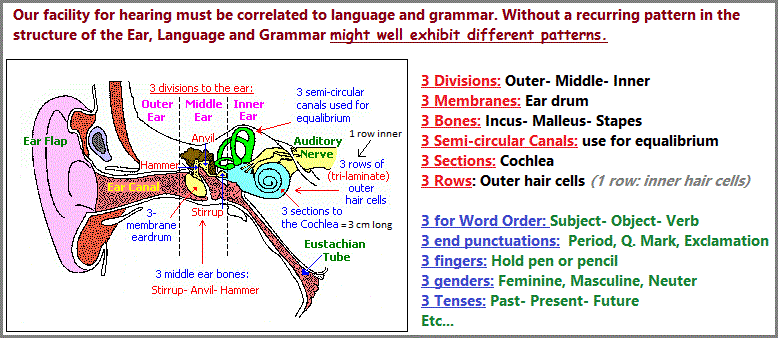
In our efforts to unravel the basics of language or that which from biology through physiology produces what is described as a repetition of pattern in human languages such as the usage of Consonants and Vowels while some researchers also cite an intermediary framed as a semi-vowel or inter-consonant, we can add to this lineup the idea of supra-segmental (also called prosodic feature, in phonetics, a speech feature such as stress, tone, or word juncture that accompanies or is added over consonants and vowels; these features are not limited to single sounds but often extend over syllables.
Along with consonants and vowels as repeating patterns, we also find the order or words, typically referred to as word order involving Subject (S), Object (O), Verb (V), as discussed in this article: The origin and evolution of word order by Murray Gell-Mann and Merritt Ruhlen, October 18, 2011.
Abstract
Recent work in comparative linguistics suggests that all, or almost all, attested human languages may derive from a single earlier language. If that is so, then this language—like nearly all extant languages—most likely had a basic ordering of the subject (S), verb (V), and object (O) in a declarative sentence of the type "the man (S) killed (V) the bear (O)." When one compares the distribution of the existing structural types with the putative phylogenetic tree of human languages, four conclusions may be drawn:
- The word order in the ancestral language was SOV (Subject- Object- Verb).
- Except for cases of diffusion, the direction of syntactic change, when it occurs, has been for the most part SOV > SVO and, beyond that, SVO > VSO/VOS with a subsequent reversion to SVO occurring occasionally. Reversion to SOV occurs only through diffusion.
- Diffusion, although important, is not the dominant process in the evolution of word order.
- The two extremely rare word orders (OVS and OSV) derive directly from SOV.
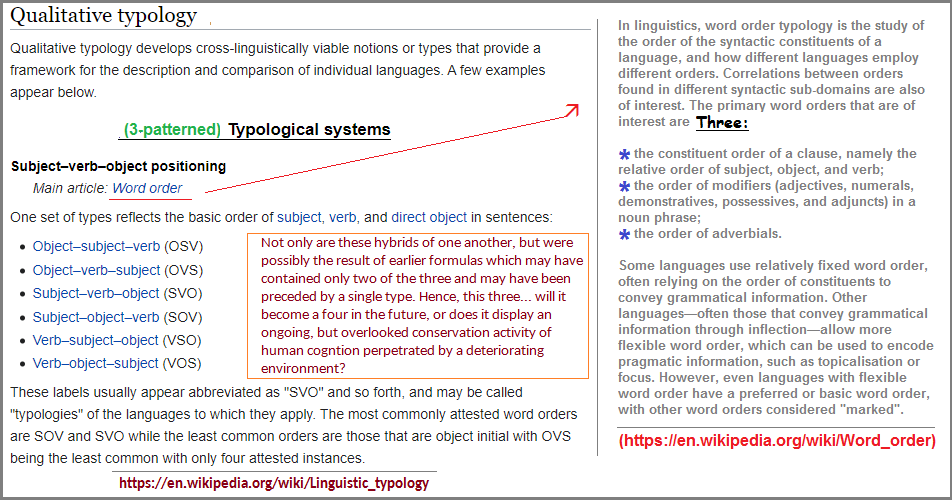
And let us not overlook that there are three aspects related to language that must be considered in the overall environment to which one is situated:
Auditory, Cognitive, and Linguistic Factors Predict Speech Recognition in Adverse Listening Conditions for Children With Hearing Loss by Ryan W. McCreery, Elizabeth A. Walker, Meredith Spratford1, Dawna Lewis and Marc BrennanDate of Origination: Friday, 30th July, 2021... 6:38 AM
Date of Initial Posting (this page): Thursday, 6th January, 2022... 8:34 AM